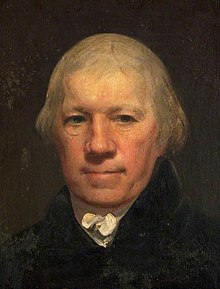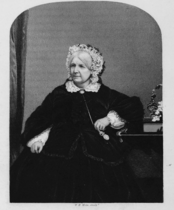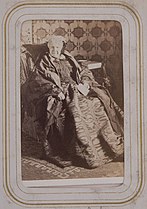Elizabeth Gordon, Duchess of Gordon
Elisabeth Gordon | |
|---|---|
 Elizabeth Gordon from Disruption Worthies[1] | |
| Personal details | |
| Born | Elizabeth Brodie 20 June 1794 |
| Died | 31 January 1864 Huntly Lodge, Aberdeenshire, Scotland |
| Spouse | George Gordon |





Elizabeth Gordon, Duchess of Gordon (née Brodie; 20 June 1794 – 31 January 1864), was a Scottish noblewoman. In 1813, she married George Gordon, Marquis of Huntly, afterwards the 5th Duke of Gordon. She was a member of the Scottish Episcopal Church but left it and joined the Free Church of Scotland in 1846. She had the nickname The Good Duchess. She is remembered as a supporter of the early Free Church and as a founder of the Gordon Schools in Huntly and of the Gordon Chapel in Fochabers.
Ancestry and education[edit]
Gordon was born in London on 20 June 1794. Her father, Alexander Brodie, was of the Clan Brodie from the north of Scotland, being a younger son of James Brodie. Her father made his fortune in India. Returning home he became a member of parliament for Nairnshire 1785–90 and Elgin Burghs. Her mother was Elizabeth Margaret, daughter of James Wemyss.[2] Her mother died when she was 6 years old. She was brought up by her maiden aunts in Elgin.[3] Carefully educated, she was the heiress of great wealth and possessed a handsome figure and a bright, joyous disposition.[4]
Marriage[edit]
She married George Gordon, Marquess of Huntly, 25 years older than herself, on 11 December 1813. Her position gave her access to the best society, but revelations of unblushing vice in high quarters distressed her and led her to study the Bible for solace under her grief. She became a most earnest believer, and after a time made a complete renunciation of the world.[4]
Becoming Duchess of Gordon in 1827, at the age of 33, she deliberately began a life of earnest devotion. She was made Mistress of the Robes in 1830. She became interested in schools, chapels, and other Christian undertakings among her own people, and when in 1836 the death of her husband, with whom she had lived in much affection, made her independent, her devotion became more intense than ever.[4]
At the point of her husband's death Elizabeth moved into the Dowager House on the estate, known as Huntly Lodge.[5]
Activities once widowed[edit]
Huntly Lodge, her residence, (now the Castle Hotel)[6] is situated in Strathbogie, one of the chief fields of the well-known conflict between the church and the civil courts previous to 1843, when the disruption of the Church of Scotland occurred.[4]
The duchess was an Episcopalian, but her sympathies were with those who were in conflict with the civil courts, though she was not disposed to identify herself with their movement. In 1846 her views changed. Believing that the Church of England was not constituted in accordance with the mind of the Lord, because it had no discipline, she left it after a long mental conflict, and joined the Free Church of Scotland. The leaders of the Free church, such as William Howels,[7] were her personal friends, and often visited her house and held religious meetings under her roof. She came to occupy among evangelical Christians in Scotland the position that in former years had been held by the Countess of Leven and Viscountess Glenorchy.[4]
The building of a church at Holyrood in Edinburgh was undertaken by the St Luke's congregation largely supported by Elizabeth.[8]
Death and legacy[edit]
Her death took place somewhat suddenly at Huntly Lodge on 31 January 1864, in her seventieth year.[4]
She is remembered as a supporter of the early Free Church and as a founder of the Gordon Schools in Huntly.[9] There is a portrait plaque of her and another of the duke inside the arched pend at the Gordon Schools.[10]
Family[edit]
Elizabeth married on 11 December 1813 in Bath.[2] Her father gave her a dowry of £100,000 about £5 million in today's equivalent.[6] After her father's death his she inherited his entire estate.[2] Lord and Lady Huntly had two nieces, Caroline[11] and Emily, daughters of William Montagu, living with them as daughters. In 1826 one of these, Lady Emily Montagu, was out of health, and they took her abroad for the winter. They do not seem to have been particularly anxious about her, and were able to enjoy their surroundings, and the society with which they mingled.[3] However Lady Emily Montagu died after a sudden imflamatory attack on 31 January 1827.[12][13] Elizabeth's husband had 3 illegitimate children: Charles Gordon, Susan Sordet, and Georgiana McCrae.[citation needed]
Portraits[edit]
-
Elizabeth Gordon by Richard James Lane
-
Elizabeth Gordon by William Essex
-
Elizabeth Gordon (née Brodie), Duchess of Gordon by Maxim Gauci from British Museum
-
Elizabeth Gordon (née Brodie), Duchess of Gordon by Abraham Bouvier from British Museum
-
Elizabeth Gordon by H W Mote
References[edit]
Citations[edit]
- ^ Wylie 1881.
- ^ a b c Mitchell 2004.
- ^ a b Hack 1883.
- ^ a b c d e f Blaikie 1890.
- ^ Scotland's Lost Buildings by Ian Gow
- ^ a b Barron 2020.
- ^ Mary Ann Constantine; Dafydd Johnston (1 April 2013). "Footsteps of Liberty & Revolt": Essays on Wales and the French Revolution. University of Wales Press. p. 353. ISBN 978-1-78316-043-3.
- ^ Brown 1893, p. 793.
- ^ HGS Mag 1925.
- ^ McCall, Alison (10 October 2012). "Portrait plaque of Elizabeth, Duchess of Gordon". Women of Scotland. Retrieved 20 April 2022.
- ^ Bulloch 1898.
- ^ Stuart 1865, p. 83.
- ^ WM Mag 1865, p. 1095.
Sources[edit]
- Balfour, Clara Lucas Liddell (1877). Women worth emulating. New York: American Tract Society. pp. 100-107.
- Barron, Jamie (26 March 2020). "The benevolent Elizabeth, Duchess of Gordon". The National Trust for Scotland. Retrieved 20 April 2022.
- Blaikie, William Garden (1890). "Gordon, Elizabeth". In Stephen, Leslie; Lee, Sidney (eds.). Dictionary of National Biography. Vol. 22. London: Smith, Elder & Co. p. 177.
 This article incorporates text from this source, which is in the public domain.
This article incorporates text from this source, which is in the public domain. - Brown, Thomas (1893). Annals of the disruption with extracts from the narratives of ministers who left the Scottish establishment in 1843 by Thomas Brown. Edinburgh: Macniven & Wallace. pp. 161-162, 365–366, 739.
- Bulloch, John Malcolm (1898). "Lady Susan Gordon, Duchess of Manchester". Scottish Notes and Queries. 12 (3). London: Chapman & Hall: 33-35.
- Bulloch, John Malcolm (1908). The gay Gordons : some strange adventures of a famous Scots family. London: Chapman & Hall. pp. 253-267.
- Hack, Mary Pryor (1883). Christian womanhood. London: Hodder and Stoughton. pp. 119-144.
 This article incorporates text from this source, which is in the public domain.
This article incorporates text from this source, which is in the public domain. - Mitchell, Rosemary (2004). "Gordon [née Brodie], Elizabeth, duchess of Gordon". Oxford Dictionary of National Biography (online ed.). Oxford University Press. doi:10.1093/ref:odnb/11032. (Subscription or UK public library membership required.)
- Smith, Elizabeth Grant (1911). Strachey, Lady (Jane Maria) (ed.). Memoirs of a Highland lady; the autobiography of Elizabeth Grant of Rothiemurchus, afterwards Mrs. Smith of Baltiboys, 1797-1830. London: J. Murray. pp. 252-253.
- Stuart, Alexander Moody (1865). Life and letters of Elisabeth last duchess of Gordon (3 ed.). London: James Nisbet & Co.
- Whittemore, William Meynell, ed. (1866). "Passages in the life of the last Duchess of Gordon". Golden hours, ed. by W. M. Whittemore. London: William Macintosh and co. pp. 44-47.
author: "A. M."
- Woods, Henry J. T. (1993). "Elizabeth Duchess of Gordon". Christian Study Library. from The Monthly Record, 1993.
- Wylie, James Aitken, ed. (1881). Disruption worthies : a memorial of 1843, with an historical sketch of the free church of Scotland from 1843 down to the present time. Edinburgh: T. C. Jack. pp. 271–278.
 This article incorporates text from this source, which is in the public domain.
This article incorporates text from this source, which is in the public domain. - The Wesleyan-Methodist Magazine. London: Wesleyen Conference Office. 1865. pp. 1092-1104.
- The Magazine of the Huntly-Gordon-Schools Former Pupils' Association (PDF). Huntly: "Express" Office. 1925. pp. 7-9.
Further reading[edit]
- Niall, Brenda. (1994) Georgiana: a Biography of Georgiana McCrae, painter, diarist, pioneer. Melbourne: Melbourne University Press. ISBN 0 522 84513 4
- McCrae, Hugh (ed) (1934, reprinted 2013) Georgiana's Journal. Melbourne 1841-1865. Canberra, Halstead Press. ISBN 9781920831585






